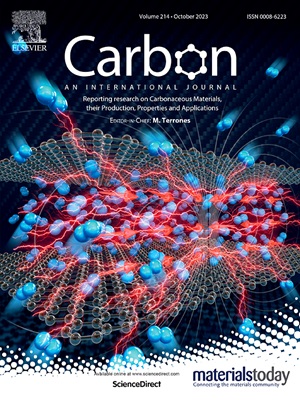多尺度隔热碳气凝胶中传导-辐射传热的结构-功能关系研究
IF 10.5
2区 材料科学
Q1 CHEMISTRY, PHYSICAL
引用次数: 0
摘要
碳气凝胶多孔结构的随机性使其成为优良的隔热材料。本文研究了碳气凝胶的传热和结构功能关系。建立了一个包含各种实验所得的多尺度结构的数据库,并提出了一个结合分子动力学、晶格玻尔兹曼方法和离散偶极子近似的模型来探索跨尺度热传导和辐射。结果表明,微尺度结构的密度和中程顺序是影响温度相关导热系数的关键因素。热导率从273 K增加到1273 K是由于频率超过16太赫兹的振动的激发。对于以低中阶原子结构为特征的气凝胶,由于进一步石墨化,热导率在温度高于1673 K时上升。在中尺度上,介孔率是气凝胶热导率的主要决定因素,与热导率呈近似线性关系。尽管温度很高,辐射仍然是热量传递的一个次要因素。基于多尺度孔隙度的差异性影响调节气凝胶结构,可以有效降低气凝胶的导热系数。对于低石墨化气凝胶,这涉及到降低微尺度密度,而对于高石墨化气凝胶,将其微尺度密度控制在1.6 g·cm−3以下可以抑制碳原子的中程顺序。本文章由计算机程序翻译,如有差异,请以英文原文为准。
Insight into structural-functional relationship for conductive-radiative heat transfer in multi-scale thermal insulating carbon aerogels
The randomness in the porous structure of carbon aerogels makes them excellent thermal insulators. This study investigates heat transfer and structural-functional relationships in carbon aerogels. A database containing multi-scale structures derived from various experiments has been constructed, and a model that integrates molecular dynamics, lattice Boltzmann method, and discrete dipole approximation is proposed to explore cross-scale heat conduction and radiation. The results indicate that the density and medium-range order of microscale structures are critical factors influencing temperature-dependent thermal conductivities. The increase in thermal conductivity from 273 K to 1273 K is attributed to the excitation of vibrations with frequencies exceeding 16 THz. For aerogels characterized by low medium-range order atomic structures, thermal conductivity rises at temperatures above 1673 K due to further graphitization. Mesoporosity emerges as the primary determinant of aerogel thermal conductivity at the mesoscale, exhibiting an approximately linear relationship with thermal conductivity. Despite high temperatures, radiation remains a minor contributor to heat transfer. Regulating aerogel structures based on differential influences of multi-scale porosity can effectively reduce their thermal conductivities. For lowly graphitized aerogels, this involves decreasing microscale density, while for highly graphitized aerogels, controlling their microscale density under 1.6 g·cm−3 can suppress the medium-range order of carbon atoms.
求助全文
通过发布文献求助,成功后即可免费获取论文全文。
去求助
来源期刊

Carbon
工程技术-材料科学:综合
CiteScore
20.80
自引率
7.30%
发文量
0
审稿时长
23 days
期刊介绍:
The journal Carbon is an international multidisciplinary forum for communicating scientific advances in the field of carbon materials. It reports new findings related to the formation, structure, properties, behaviors, and technological applications of carbons. Carbons are a broad class of ordered or disordered solid phases composed primarily of elemental carbon, including but not limited to carbon black, carbon fibers and filaments, carbon nanotubes, diamond and diamond-like carbon, fullerenes, glassy carbon, graphite, graphene, graphene-oxide, porous carbons, pyrolytic carbon, and other sp2 and non-sp2 hybridized carbon systems. Carbon is the companion title to the open access journal Carbon Trends. Relevant application areas for carbon materials include biology and medicine, catalysis, electronic, optoelectronic, spintronic, high-frequency, and photonic devices, energy storage and conversion systems, environmental applications and water treatment, smart materials and systems, and structural and thermal applications.
 求助内容:
求助内容: 应助结果提醒方式:
应助结果提醒方式:


